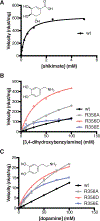Dynamic Conformational States Dictate Selectivity toward the Native Substrate in a Substrate-Permissive Acyltransferase
- PMID: 27805809
- PMCID: PMC6276119
- DOI: 10.1021/acs.biochem.6b00887
Dynamic Conformational States Dictate Selectivity toward the Native Substrate in a Substrate-Permissive Acyltransferase
Abstract
Hydroxycinnamoyl-CoA:shikimate hydroxycinnamoyltransferase (HCT) is an essential acyltransferase that mediates flux through plant phenylpropanoid metabolism by catalyzing a reaction between p-coumaroyl-CoA and shikimate, yet it also exhibits broad substrate permissiveness in vitro. How do enzymes like HCT avoid functional derailment by cellular metabolites that qualify as non-native substrates? Here, we combine X-ray crystallography and molecular dynamics to reveal distinct dynamic modes of HCT under native and non-native catalysis. We find that essential electrostatic and hydrogen-bonding interactions between the ligand and active site residues, permitted by active site plasticity, are elicited more effectively by shikimate than by other non-native substrates. This work provides a structural basis for how dynamic conformational states of HCT favor native over non-native catalysis by reducing the number of futile encounters between the enzyme and shikimate.
Figures





References
-
- Weng JK, and Noel JP (2012) The remarkable pliability and promiscuity of specialized metabolism, Cold Spring Harb. Symp. Quant. Biol. 77, 309–320. - PubMed
-
- Jensen RA (1976) Enzyme Recruitment in Evolution of New Function, Annu Rev Microbiol 30, 409–425. - PubMed
-
- Peisajovich SG, and Tawfik DS (2007) Protein engineers turned evolutionists, Nat Methods 4, 991–994. - PubMed
-
- Aharoni A, Gaidukov L, Khersonsky O, Gould SM, Roodveldt C, and Tawfik DS (2005) The ‘evolvability’ of promiscuous protein functions, Nat Genet 37, 73–76. - PubMed
MeSH terms
Substances
Grants and funding
LinkOut - more resources
Full Text Sources
Other Literature Sources
Molecular Biology Databases

